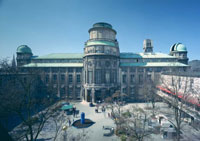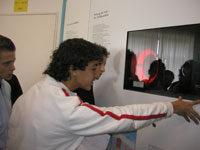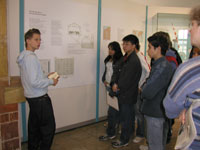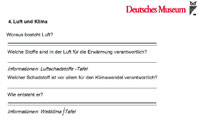Travel wisely: the globe is warming! Teach article
Elisabeth Schepers from the Deutsches Museum in Munich, Germany, introduces a school programme linking climate change and the future of traffic technology.

Munich
Image courtesy of the
Deutsches Museum
The Earth’s climate is warming, mostly as a result of increasing carbon dioxide (CO2) levels in the atmosphere. Today, traffic is held responsible for one fifth of this increase. Rising levels of the greenhouse gas CO2 will lead to further global warming and will restrict life on Earth. Furthermore, fossil fuels – the most important energy source for our civilisation – are limited. Humans will soon have to switch to alternative energy sources – if not today, then in the near future. But mobility is one of our basic needs: to live comfortably involves transporting goods, energy or ourselves.
To live, we need to move, but by moving, we destroy the environment in which we live. How can we solve this dilemma? The Deutsches Museumw1 addressed this question with students aged 10-16, in a PENCIL project (see box) involving three messages:
- Climate is a system and we are part of it. Individually, we make a minute contribution to this system, but the effects of our collective contributions can be devastating – such as tropical storms in Europe.
- The key is creative solutions, such as alternative fuels, regenerative energies and different approaches to mobility. What options do we have? Which one is right for me?
- As we all produce CO2, we all share the responsibility. What can we do to address these responsibilities?
Climate and education experts from the Deutsches Museum worked with teachers from 15 secondary schools to develop activities based on current climate research and the future of traffic technology. The project, run in the environment gallery and the traffic museum of the Deutsches Museum, aims to develop students’ basic research skills and individual opinion-building capacities, to take an interdisciplinary, cross-curricular approach, and to be socially inclusive.
The first message is addressed in a visit to the environment gallery, which investigates the climate system and the effects that a change in one sub-system has on all other sub-systems. The second message is discussed in a further visit, to the traffic museum, where students come up with questions and recommendations for stakeholders such as the municipality, local car manufacturers, automobile clubs or transport companies. The third message forms the centre of a role-play that invites students to use the information they have collected in the first two activities and from the dedicated website to develop their own opinions about the topic and to exchange the arguments for and against specific traffic developments.
Typically, special programmes at the Deutsches Museum have been visited mostly by primary schools or elite secondary schools (Gymnasien). To reach a wider range of students, we invited less-elite secondary schools to take part in the development of the climate change project. The response from these schools was very positive, and the involvement of teachers from different subjects and types of schools helped us to develop a project with a basic structure but versatile contents.
Visiting the museum

pixelquelle.de /Kurt Michel
In the course of a 90-minute visit to the museum, the topic of climate change and traffic is used to introduce students to current scientific research and model building as well as to the political and individual options following this research.
For example, in the hurricane activity in the environment gallery, students are introduced to the effects of weather disasters such as hurricanes in Europe. Students particularly wanted to deal with real threats when learning about climate change, not just with models or theoretical information. The abstract ‘global warming’ caused by increasing CO2 levels results not only in sunnier summer days, but also extreme weather such as the aforementioned hurricane.
As an example of climate change, we therefore chose Hurricane Vince, which struck the Iberian peninsula in October 2005. Currently, there are no reliable precautions against tropical storms in Europe. The question to the students is: how can we avoid tropical storms in non-tropical regions of the world? To answer this question, students choose from a range of different research tasks.

the greenhouse effect to his
classmates
Image courtesy of the
Deutsches Museum
Working in small groups, students are introduced to their research task by a museum educator and then use a worksheet to collect information from the museum galleries. A great deal of care was put into developing the worksheet, which presents a main research task – one of seven questions leading to a final answer on how to avoid hurricanes in Europe. Topics include the model of the climate system, constituents of the atmosphere and the contribution of traffic to the pollutants, a physical experiment, historical and geographical information, climate politics, personal options and an overview of renewable energies. Students are encouraged not only to answer the questions, but also to discuss the issues and come up with further questions for the museum educator. For
Next, students take their peers on a tour of the gallery, presenting their research findings, answering further questions, referring to previous presentations, and using the museum’s experiments and interactive exhibits to visualise their findings. Museum educators help out with missing information, linking the single presentations to the central topic and, most importantly, encouraging the students to contribute and research further.
Students who visit are amazed that teenagers can have political influence, for example as consumers, participants of traffic or members of environmental groups. They start discussing the pros and cons of some of the topics during the group presentation: will there be floods in Europe? Does my contribution make a difference? If we decrease CO2 emissions, will the temperature fall immediately? Teachers appreciate the all-embracing approach of the programme, as school curricula are usually more detailed but lack an overall view of a topic.
A corresponding programme is being designed in the traffic museum, covering topics such as pollutants, renewable fuels, alternative engines and mobility as a basic human need. Together, the programmes develop an understanding of the role that traffic plays in climate change and the personal options that people have to influence this. They also reveal the impact not only of climate but also of society and make students aware of their responsibility.
Role play
In the next stage, role-plays are used to introduce students to scenarios that require them to make a decision, for example:
- How should I do the weekly shopping for my family?
- Where should I shop, and how should I get there?
- Should I stop driving and shop via the Internet instead?

renewable energies? This
student introduces his peers
to different options
Image courtesy of the
Deutsches Museum
he students already have some general information on these topics from their museum visit. To encourage more discussion and opinions, students are given statements from people involved in traffic and climate issues, such as the manager of a car company or the bicycle club, a Green Cityw6 representative, or a professor for traffic development. These materials will shortly be available on the website of the Deutsches Museumw2.
For each of three scenarios, the role-play pack includes statements that present a number of arguments and opinions, enabling the students to exchange views that they share or to provoke debate. The pack also includes advice for the moderator of the role-play, who can be a student or a teacher.
The role-play can take place after one of the museum programmes or back at school. Either way, students recall the information from the museum visit (or the website) and argue from different points of view. As a result, they develop their own opinion on climate change, personal options, renewable energies and so forth, rather than adopting an institutional point of view.
Website
To help teachers follow up the museum visits in the classroom, the website of the Deutsches Museum provides information on climate changew2, with a new section on climate change and traffic. The information is provided in both English and German, and addresses seven general climate topics. Another new section is particularly appropriate for the project, covering the greenhouse effect, climate change, climate system, Antarctica, climate history, climate politics, a game, and climate and traffic, including alternative fuels and new motor technologies and ideas about future mobility.
Evaluation
How did the project develop? It involved an intense co-operation between teachers, their students and the museum.
Initially, the opinions of 133 students from different schools and school types were surveyed. Most had no basic knowledge of the context of climate change and traffic. They were interested in climate disasters, but not so much in climate politics or the climate system. They were looking for sensations rather than the political or scientific background.

questions guiding through
the work assignment. Hints
on where to find the
information save the
students from too much
reading. The lines for taking
notes help structure the
presentation. Click to enlarge
image
Image courtesy of the
Deutsches Museum
The 16 teachers involved in the project wanted to address renewable energies and changes in personal behaviours in an attempt to combat climate change. Once again, climate politics was not seen as important.
On the basis of this evaluation, the topics were chosen. We used a sensation (the hurricane in Europe) as an introduction and concluded with the personal challenge to deal with climate change. In between, we considered the teachers’ wishes for an all-embracing approach and included the climate system. To avoid leaving students with a feeling of helplessness and despair, information on the Intergovernmental Panel on Climate Change (IPCC) was included.
Regardless of age and school, students who took part in the next stage of the evaluation enjoyed learning outside the classroom, working on activities and experiments with friends and experts, and actively drawing information from experts rather than passively listening. Some wanted the activities to be less structured, allowing them to do experiments and interact with elements of the exhibition, or even solve a mystery. They did not want to fill in questionnaires.
Teachers also appreciated the experiments and mystery tasks but were not so keen on ‘free work’. They wanted guided tours by experts and questionnaires for students to fill in, if possible in multiple-choice format.
Using this feedback from students and teachers, we combined the approaches in the current programme, mixing a worksheet that involves active participation by the students with a more dialogue-based format of presentations and role-plays.
Since the revised programme was opened to all schools in Febuary 2007, the evaluation findings have been proven many times. Teachers appreciate the mix of structure and free work of the students, students enjoy working in a different setting, using oral rather than writing skills and discussing with an expert. The programme runs about once a week – and the demand is such that it could run more frequently but for the limited staff resources of the Deutsches Museum education department.
PENCIL
The Deutsches Museum project is one of the activities in the PENCIL projectw3 (Permanent EuropeaN resource Centre for Informal Learning). PENCIL, co-ordinated by Ecsitew4 and funded by the European Commission as part of the NUCLEUS clusterw5, aims to strengthen the operational relations between schools and informal science education in science centres and museums.
Fourteen science centres and museums have developed pilot activities in partnership with teachers and schools; material is already available online. Academic and school partners are now working to identify key ways to transform informal science activities into innovative, high-quality tools for science teaching.
Web References
- w1 – The Deutsches Museum is one of the biggest European science museums.
- w2 – Materials on climate change are available on the Deutsches Museum website.
- w3 – Information about PENCIL is available on the Xplora website.
- w4 – The website of Ecsite, the European organisation representing science centres and museums.
- w5 – Information about NUCLEUS is available on the Xplora website.
- w6 – Green City is a non-governmental organisation working to improve Munich’s quality of life through ecological urban planning.
Resources
- For more information on formal, non-formal and informal learning, see:
- Davies P (2004) Anerkennung und Wertschätzung informellen und formellen Lernens. In John H, Thinesse-Demel J (eds) Lernort Museum – neu verortet. Bielefeld, Germany: Transcript Verlag für Kommunikation, Kultur und soziale Praxis
- Black G (2005) The Engaging Museum: Developing Museums for Visitor Involvement. New York, NY, USA: Routledge
- Weber T (2002) Learning in schools and learning in museums: which methods best promote active learning? In Calcagnini S, Felfoldi Z, Van Den Bosch J, Xanthoudaki M (eds) A Manual of Good Practice Based on the Collaboration Between Science Museums and Schools. Milan, Italy: Museo Nazionale della Scienza e della Tecnologia
- Bevan B, Semper RJ (2006) Mapping Informal Science Institutions onto the Science Education Landscape
- Science on Stage Deutschland (2006) The importance of interdisciplinary education. In Teaching Science in Europe. Berlin, Germany.
- Lewalter D, Geyer C (2005) Die Evaluation der Homepage des ZNT. In Noschka-Roos A, Hauser W, Schepers E (eds) Mit neuen Medien im Dialog mit den Besucher pp 32-42. Berlin, Germany: G+H Verlag





